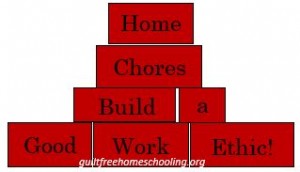I’ve often been asked how we raised our kids, by those who are up to their armpits in the midst of the power struggle that parenthood can sometimes be. The answer is one long day at a time, but with the help of some very consistent rules. I should clarify that many of these weren’t unbreakable rules as much as they were our family’s unique customs or our preferred methods for handling specific situations. I didn’t remember having a lot of rules for my kids, but my now-adult children have reminded me of several of them over the years. They recognize behaviors in others that they were not allowed to do and say “You never let us do that!”—and I’m pleased to say they mean it as a compliment. My daughter, Jennifer, has often caught herself watching her friends’ or coworkers’ exploits and thinking “If you were my mom’s child…” She has quoted some of our family rules as if they were The Wisdom of the Ages, only to have the hearer ask “Who says?” “Umm… my mom and I!” is her reply as she realizes that, unfortunately, the rest of civilization has yet to catch up to Mom’s Standards for Proper Conduct.
Some of our rules applied to my children, some to us as a family unit, and some were reminders for me as a parent that good kids don’t just happen. Kids obey best when they understand the reason behind a rule, whether they participated in the decision-making process that created that rule or not. Most rules are made to govern the future as well as the present: “Don’t run out into the street” is for right now, but also for every time in the future that a speeding car promises harm. Whatever rules your family makes, be sure to craft them with one eye on the future, and help your kids understand that the future-aspect is there to help them learn how to grow up into responsible adults. After all, “parent” is a verb, and you can’t expect great results from doing nothing. [“Parent” Is a Verb, linked below]
Overwhelmingly, I used the Golden Rule (Treat others as you wish to be treated—Luke 6:31, paraphrased) to teach my kids appropriate behavior and respect for others’ feelings and property. From toddlerhood on, I explained (in language suited to their understanding) what they had done wrong, why it was wrong, how it made the other person feel, and what their response should have been (the preferred behavior). Once they understood the situation from the other side, then they were able to offer a truly sincere apology, if circumstances required it. Beyond that, the detailed explanations helped those little people learn to think things through and anticipate the cause and effect relationship of actions to outcomes. You should not have kicked your ball into the neighbor’s flower bed. Your ball broke several of their pretty flowers, and they had just bought those plants and worked hard to get them all planted today. You can kick your ball over here where there is plenty of open space, but you may not kick it so hard that it lands near those flowers again. Do you understand the difference? If you disobey and kick the ball into the flowers again, you will be punished. Do you understand?
My kids were allowed to repeat certain actions only 3 times and no more. Whether it was running circles around the kitchen table or bouncing a beach ball off the top of my head, they could get away with it three times. Behavior that would have hurt someone or something was stopped immediately, but otherwise let’s just say that they learned to obey the limit. Auditory learners and making noises go together like air and breathing, but the “Rule of 3” taught them to stop the repetitive noises after 3 times and save the remainder for more appropriate situations, such as when playing outside, or when in their rooms and not disturbing others. [My “Rule of 3,” linked below]
Nearly every “rule” we had was an extension of the respect relationship taught through the Golden Rule. Do you want your little brother barging into your room without knocking? Then be sure that you knock on his door before entering his room. The Rule of 3 was built upon respect for others’ personal space, and respect is in itself a Golden Rule relationship. Respect must be earned—it isn’t granted automatically. If you want it, what are you doing to deserve it? [Respect Must Be Earned, linked below]
Family is spelled T-E-A-M, and we are all on the same side. No one here is your enemy, especially not your siblings. Family is not a competition, and we’re all in this together. [Family Is Spelled T-E-A-M, linked below]
Speaking of teams, Mom should not be the only person working while everyone else is playing, because moms like to play, too. Get the household staff working—fill those machines and get them running, so you can feel good about all the jobs that are getting done. Teach your kids that if we get the chores out of the way first, then we can take a break, guilt-free. Work first, then play. [Using Your Household Staff, linked below]
I taught my kids not to interrupt a conversation (especially between adults), unless there was a true emergency involving large amounts of water, blood, and/or fire. I told them that if they stood quietly next to me while I was involved in a conversation that: 1) I would know they had something to tell me, 2) I would not forget about them being there, and 3) I would listen to them at the next appropriate moment. I also taught them to hold up one finger to help them remember what it was they wanted to say (or 2 fingers to remember 2 things—and it really does work). Yes, it was appropriate to wake Mom and Dad from a Sunday afternoon nap to report that the house next door was on fire. It led to very important life-lessons in how to remain calm in a crisis, how to use a fire extinguisher, and how long it takes from the time someone dials 911 until you can actually hear the fire truck’s siren. Good job! (Yes, that really happened, but no one was hurt, and insurance covered the damages.)
Whining, begging, nagging, and asking again and again will never convince me to change my mind. However, if you can present your case with facts and logic and without whining, then I will listen with an open mind. Notice that this is a two-way contract. My part of the agreement was to listen attentively to the logically reasoned case my kids presented, putting aside my preconceived notions about the topic and honestly considering the points they made. The result was that very often I had to reconsider and go with their proposal, because it truly was a better idea. [If You Can Present Your Case with Facts and Logic and Without Whining, I Will Listen with an Open Mind, linked below]
We discussed “our family’s values” so that each child understood why we do what we do, why we don’t do what someone else may do, and why we hold tightly to our specific beliefs and values. It made an amazing difference in helping our kids make up their own minds when confronted with peer pressure.
As part of understanding our family’s values, my kids were taught to respect the rules and value systems of other children’s parents by not sharing their opinions on whether they thought those rules were correct. When a friend said, “I wish my Mom used your Mom’s rule,” my daughter explained that our family probably also had a few rules that the friend wouldn’t like, so the friend shouldn’t automatically assume that one family was better than another. This also applied to individual privileges, schooling or homeschooling methods, TV or movie choices, church programs, family activities, and just about anything else that could prompt a comparative discussion.
My most controversial rule (as viewed by my peers) was that “authority” figures who had no true authority over my kids (not their parent or police, etc.) and/or who were clearly wrong (meaning they had the facts wrong) did not necessarily need to be listened to or obeyed. This came into play when a bully-parent (one of those aforementioned peers who disagreed with my views, particularly this one) made a faulty assumption about my son, after overhearing a snippet of conversation between my son and another boy at a homeschool group function. That parent attempted to exert her “authority” (just because she was an adult) over the boys because of what she thought she heard, but my son (knowing the full context of the conversation) knew she was in error and tried to explain the misunderstanding. She threatened to tell his mother (me) that he had argued with her, and he dared her to follow through on that, because he knew he wasn’t guilty of doing anything wrong. When she gave me her side of the story, it sounded completely out of character for my son, so I turned to him for his explanation (which made her even angrier to think that I would accept the word of a 13-year-old over her testimony). The outcome was that I didn’t destroy a family relationship because of another adult’s misconception. Adults can be wrong, and kids learn to honor truth by seeing their parents recognize that adults are not always right just because they are adults. A parallel rule to the false-authority issue was that if anyone said to my kids “Don’t tell your parents,” that was our family’s code for “Run immediately to your parents and tell them everything!” That was also played out, with the result that my child identified right away that the person saying it was up to no good. Reporting the conversation to her parents was the equivalent of calling in the cavalry and turning the problem over to someone who could stop it from escalating into a more harmful situation. Crisis averted; family relationships secured.
Our family used “Because I said so” as valid reasoning under very special conditions, usually a minor emergency or some similar circumstance. Spoken quietly and surreptitiously, it was another code phrase that meant “Do what I say now, and I will explain the why later, as soon as I have the chance.” Everyone recognized that hearing the phrase “because I said so” meant something was seriously wrong and immediate, unquestioned obedience was required for the safety and well-being of one or more family members. We were careful not to over-use this or use it frivolously, so that it maintained its emergency-situation-only status. In our family, it was used by both parents and children, depending on the circumstances, which varied from “That kid has been mean to me before, and I really don’t want to run into him right now” to quickly leaving public situations that suddenly became uncomfortable or appeared unsafe. The full explanation that came later always assured us that the hasty exit had been completely justified.
The “family whistle” was a signal we used to find each other in large stores, get someone’s attention, or call to each other in surroundings where shouting might not be noticed. We used a unique melody of 3-4 notes that signaled us to “Come now.” We started using the non-shrill whistle when our kids were nearing middle-school age, and it was a wonderfully subtle way to signal each other in large groups. Most by-standers never even noticed.
As with any set of rules, consistency is crucial. As adults, we need to know that other drivers will obey the rule that a red traffic light means Stop and a green light means Go. Kids need the exact same consistency in knowing that their parents’ rules mean what they say. Without consistency, the rules break down, and before you know it, everyone is going, no one is stopping, and chaos is the result. Set your family rules, be consistent in their execution, and enjoy the freedom that results.
See these articles for more complete explanations:








 Guilt-Free Homeschooling is the creation of Carolyn Morrison and her daughter, Jennifer Leonhard. After serious disappointments with public school, Carolyn spent the next 11 years homeschooling her two children, from elementary to high school graduation and college admission. Refusing to force new homeschooling families to re-invent the wheel, Carolyn and Jennifer now share their encouragement, support, tips, and tricks, filling their blog with "all the answers we were looking for as a new-to-homeschooling family" and making this website a valuable resource for parents, not just a daily journal. Guilt-Free Homeschooling -- Equipping Parents for Homeschooling Success!
Guilt-Free Homeschooling is the creation of Carolyn Morrison and her daughter, Jennifer Leonhard. After serious disappointments with public school, Carolyn spent the next 11 years homeschooling her two children, from elementary to high school graduation and college admission. Refusing to force new homeschooling families to re-invent the wheel, Carolyn and Jennifer now share their encouragement, support, tips, and tricks, filling their blog with "all the answers we were looking for as a new-to-homeschooling family" and making this website a valuable resource for parents, not just a daily journal. Guilt-Free Homeschooling -- Equipping Parents for Homeschooling Success!

Recent Comments